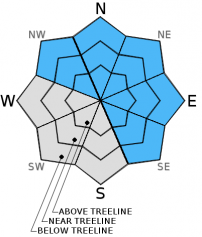| Saturday | Saturday Night | Sunday | |
|---|---|---|---|
| Weather: | Cloudy with snow showers | Mostly cloudy | Cloudy with a slight chance of snow in the morning and better chances of snow in the afternoon |
| Temperatures: | 34 to 39 deg. F. | 23 to 27 deg. F. | 33 to 38 deg. F. |
| Mid Slope Winds: | Southwest | Southwest | Southwest |
| Wind Speed: | 30 to 40 mph with gusts to 60 mph | 20 to 35 mph with gusts to 50 mph decreasing to 15 to 25 mph with gusts to 40 mph after midnight | 15 to 25 mph with gusts to 40 mph increasing to 30 to 45 mph with gusts to 65 mph in the afternoon |
| Expected snowfall: | 1 to 4 | 0 | up to 3 |
| Saturday | Saturday Night | Sunday | |
|---|---|---|---|
| Weather: | Cloudy with snow showers | Mostly cloudy | Cloudy with a slight chance of snow in the morning and better chances of snow in the afternoon |
| Temperatures: | 29 to 34 deg. F. | 22 to 27 deg. F. | 29 to 34 deg. F. |
| Ridge Top Winds: | Southwest | Southwest | Southwest |
| Wind Speed: | 40 to 60 mph with gusts to 90 mph | 55 to 60 mph with gusts to 85 mph decreasing to 40 to 45 mph with gusts to 65 mph after midnight | 35 to 40 mph with gusts to 60 mph increasing to 55 to 60 mph with gusts to 90 mph in the afternoon |
| Expected snowfall: | 1 to 4 | 0 | up to 3 |























